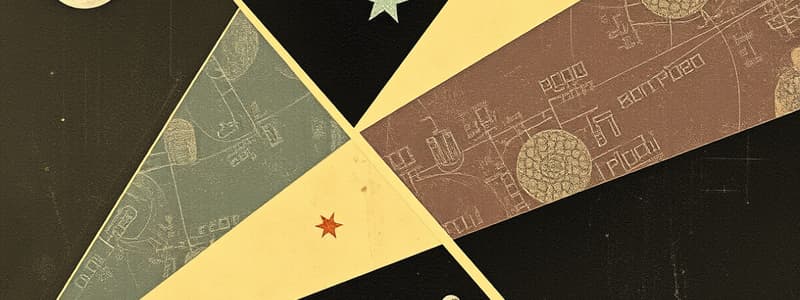Podcast
Questions and Answers
What is the definition of Midpoint?
What is the definition of Midpoint?
A point which divides a segment into 2 congruent segments.
What is the definition of Segment Bisector?
What is the definition of Segment Bisector?
A line, segment, or plane that goes through the midpoint of a segment.
What is the definition of Angle Bisector?
What is the definition of Angle Bisector?
A ray, a plane, a line, or a segment that divides an angle into 2 congruent angles.
What is the definition of Right Angle?
What is the definition of Right Angle?
What are Complementary Angles?
What are Complementary Angles?
What are Supplementary Angles?
What are Supplementary Angles?
What does Congruence mean?
What does Congruence mean?
What are Perpendicular Lines?
What are Perpendicular Lines?
What is the Segment Addition Postulate?
What is the Segment Addition Postulate?
What is the Angle Addition Postulate?
What is the Angle Addition Postulate?
Any 2 points are located on the same line.
Any 2 points are located on the same line.
What does the Midpoint Theorem state?
What does the Midpoint Theorem state?
What does the Supplement Theorem state?
What does the Supplement Theorem state?
What does Congruent Supplement Theorem state?
What does Congruent Supplement Theorem state?
What does the Perpendicular Line Form Right Angles Theorem state?
What does the Perpendicular Line Form Right Angles Theorem state?
What does the All Right Angles are Congruent Theorem state?
What does the All Right Angles are Congruent Theorem state?
What does the 2 Angles that are Supplementary and Congruent then both are Right Angles Theorem state?
What does the 2 Angles that are Supplementary and Congruent then both are Right Angles Theorem state?
What does the 2 Congruent Angles that form a Linear Pair are Right Angles Theorem state?
What does the 2 Congruent Angles that form a Linear Pair are Right Angles Theorem state?
What is the Complement Theorem?
What is the Complement Theorem?
Vertical angles are congruent.
Vertical angles are congruent.
What does the Perpendicular Lines form Congruent Adjacent Angles Theorem state?
What does the Perpendicular Lines form Congruent Adjacent Angles Theorem state?
What does the Common Segment Theorem state?
What does the Common Segment Theorem state?
What does the Common Angle Theorem state?
What does the Common Angle Theorem state?
What is the Addition Property?
What is the Addition Property?
What is the Subtraction Property?
What is the Subtraction Property?
What is the Symmetry Property?
What is the Symmetry Property?
What is the Distributive Property?
What is the Distributive Property?
What is the Reflexive Property?
What is the Reflexive Property?
What is the Transitive Property?
What is the Transitive Property?
What is the Multiplication Property?
What is the Multiplication Property?
What is the Division Property?
What is the Division Property?
What is the Substitution Property?
What is the Substitution Property?
Flashcards are hidden until you start studying
Study Notes
Geometry Proof Terms
- Midpoint: Point dividing a segment into two equal parts.
- Segment Bisector: A line, segment, or plane passing through the midpoint, effectively bisecting the segment.
- Angle Bisector: A ray, line, or segment that divides an angle into two equal angles.
- Right Angle: An angle measuring 90 degrees.
- Complementary Angles: Two angles whose measures add up to 90 degrees.
- Supplementary Angles: Two angles whose measures sum to 180 degrees.
- Congruence: Indicates that angles, shapes, or segments have the same size and measure, denoted by ≅.
- Perpendicular Lines: Two lines or rays that intersect to form right angles.
- Segment Addition Postulate: If point B lies between A and C, then ( AB + BC = AC ).
- Angle Addition Postulate: If point S is in the interior of angle PQR, then ( \angle PQS + \angle SQR = \angle PQR ).
- 2 Points are Always Collinear Postulate: Any two points are always on the same straight line.
- Midpoint Theorem: A segment's midpoint creates two congruent segments.
- Supplement Theorem: Two angles forming a linear pair are supplementary (sum to 180 degrees).
- Congruent Supplement Theorem: If two angles both sum with another to 180 degrees, they are congruent.
- Perpendicular Line Form Right Angles Theorem: Intersecting lines at right angles create four right angles.
- All Right Angles are Congruent Theorem: All right angles are congruent to each other.
- 2 Angles that are Supplementary and Congruent then both are Right Angles Theorem: Supplementary and equal angles are right angles.
- 2 Congruent Angles that form a Linear Pair are Right Angles Theorem: Congruent angles forming a linear pair must be right angles.
- Complement Theorem: If the non-common sides of two adjacent angles form a right angle, the angles are complementary.
- Vertical Angles are Congruent Theorem: Vertical angles are congruent.
- Perpendicular Lines form Congruent Adjacent Angles Theorem: Perpendicular lines create two congruent adjacent right angles.
- Common Segment Theorem: If two segments are congruent, the segments connecting their endpoints will also be congruent.
- Common Angle Theorem: If two angles share a common angle and are congruent, their measures are also equal.
- Addition Property: If two quantities are equal, adding the same quantity to both maintains equality.
- Subtraction Property: Subtracting the same quantity from two equal quantities sustains equality.
- Symmetry Property: If one quantity equals another, the reverse is also true.
- Distributive Property: The product of a number with a sum equals the sum of the products.
- Reflexive Property: Any quantity equals itself.
- Transitive Property: If one quantity equals a second, which also equals a third, the first equals the third.
- Multiplication Property: If two quantities are equal, multiplying both by the same number remains equal.
- Division Property: If two quantities are equal and the divisor is not zero, dividing both maintains equality.
- Substitution Property: A quantity equal to another can be substituted into any expression or equation.
Studying That Suits You
Use AI to generate personalized quizzes and flashcards to suit your learning preferences.




